To Jerry, for all his help and kindness. Barbara Grunes
To Lian and Daniel, the ultimate wok kids, And to Marv, for his constant support. Virginia Van Vynckt
ASK US WHICH PAN WE WOULD WANT IF WE WERE CAST AWAY ON A DESERT ISLAND, AND THERES NO QUESTION: ITS THE WOK. BUILD A FIRE AND YOU CAN COOK ANYTHING IN A WOK.  AND WE DO MEAN ANYTHING, ANYWHERE. YEARS AGO, VIRGINIA WAS ON A HIKING TRIP IN THE HEART OF INDIAS THAR DESERTTHE VERY DEFINITION OF THE MIDDLE OF NOWHEREAND ENJOYED A SILKY, PERFECTLY COOKED CUSTARD, COMPLETE WITH CARAMELIZED SUGAR, FOR DESSERT. THE FRENCH-TRAINED EXPEDITION COOK HAD BURIED HIS WOK-LIKE PAN IN SAND HEATED BY THE WOOD FIRE TO SLOWLY BAKE HIS CRME CARAMEL. NOW THATS COOKING.
AND WE DO MEAN ANYTHING, ANYWHERE. YEARS AGO, VIRGINIA WAS ON A HIKING TRIP IN THE HEART OF INDIAS THAR DESERTTHE VERY DEFINITION OF THE MIDDLE OF NOWHEREAND ENJOYED A SILKY, PERFECTLY COOKED CUSTARD, COMPLETE WITH CARAMELIZED SUGAR, FOR DESSERT. THE FRENCH-TRAINED EXPEDITION COOK HAD BURIED HIS WOK-LIKE PAN IN SAND HEATED BY THE WOOD FIRE TO SLOWLY BAKE HIS CRME CARAMEL. NOW THATS COOKING.
We dont expect that youll embark on so chancy a venture, but you can use the wok for virtually every type of cooking method. Cooks in China and other Asian countries have been using woks and similar pans for millennia to stir-fry, deep-fry, steam, boil, poach, braise, and smoke foods. The woks deep, rounded shape distributes heat well and makes it the ideal all-purpose pan.
When you have a wok, you can toss together a one-dish dinner for four in ten minutes or cook an elaborate banquet, from dumplings to dessert, using just one pan. You can quickly stir-fry broccoli or snow peas to tender-crispness. You can deep-fry oysters and vegetables into an irresistible tempura. You can steam a white chocolate bread pudding to die for. You can grill-wok mussels to smoky sweetness.
If your wok has been gathering dust or if you have never quite gotten around to buying one, nows the time to fire up that wonderful pan. After all, the single best way to season a wok is to simply use it as much as possible.
Wok Every Day explains in detail how to buy a wok, season it, care for it, and use it day in and day out for stir-frying, deep-frying, steaming, braising, poaching, boiling, smoking, and even grill cooking. It guides you through ingredients and basic preparation. Youll soon find yourself using your wok for all sorts of everyday and special-occasion meals, not just that twice-annual Chinese dinner.
In Wok Every Day, we naturally honor the pans Chinese lineage. After all, wok is a Cantonese word, and stir-frying originated in China. But the book also celebrates the use of the wok or similar pans in kitchens throughout Asia, in places as far removed from one another as Korea and Myanmar (Burma). It also recognizes the enduring and increasing popularity of woks in the kitchens of North America and other regions in the West. The wok is just as suitable for frying chicken and cooking ravioli as it is for stir-frying beef and steaming dumplings.
So get out that wok and enjoy!
EQUIPMENT
CHOOSING AND CARING FOR YOUR WOK
BEFORE YOU CAN COOK IN A WOK, YOU HAVE TO BUY ONE. OR, IF YOU ALREADY OWN ONE THAT HAS BEEN GATHERING DUST, YOU NEED TO GET IT OUT OF THE CUPBOARD, CLEAN IT, RESEASON IT, IF NECESSARY, AND START USING IT.  TRUE, YOU CAN STIR-FRY IN A DEEP SKILLET (ALSO CALLED A SAUT PAN), BUT IT REALLY IS NOT THE SAME. THE WOKS DEEP, SLOPING SIDES MAKE IT A UNIQUE, ALL-PURPOSE PAN. MOST MANUFACTURERS OF ASIAN-STYLE COOKWARE USE THE TERMS WOK AND STIRFRY PAN INTERCHANGEABLY. WE PREFER THE TERM WOK BECAUSE YOU CAN USE THIS MARVELOUS PAN FOR ALL SORTS OF COOKING METHODS OTHER THAN STIR-FRYING.
TRUE, YOU CAN STIR-FRY IN A DEEP SKILLET (ALSO CALLED A SAUT PAN), BUT IT REALLY IS NOT THE SAME. THE WOKS DEEP, SLOPING SIDES MAKE IT A UNIQUE, ALL-PURPOSE PAN. MOST MANUFACTURERS OF ASIAN-STYLE COOKWARE USE THE TERMS WOK AND STIRFRY PAN INTERCHANGEABLY. WE PREFER THE TERM WOK BECAUSE YOU CAN USE THIS MARVELOUS PAN FOR ALL SORTS OF COOKING METHODS OTHER THAN STIR-FRYING.  WHEN BUYING A WOK, YOU NEED TO DECIDE WHAT TYPE AND SHAPE TO GET NOT AN EASY DECISION BECAUSE MANY KINDS OF WOKS AND SIMILAR PANS ARE AVAILABLE THESE DAYS. BASICALLY, YOUR DECISIONS BOIL DOWN TO THREE: WHETHER TO BUY A ROUND- OR FLAT-BOTTOMED WOK, WHAT SIZE OF PAN YOU NEED, AND WHAT MATERIALS IT SHOULD BE MADE OF.
WHEN BUYING A WOK, YOU NEED TO DECIDE WHAT TYPE AND SHAPE TO GET NOT AN EASY DECISION BECAUSE MANY KINDS OF WOKS AND SIMILAR PANS ARE AVAILABLE THESE DAYS. BASICALLY, YOUR DECISIONS BOIL DOWN TO THREE: WHETHER TO BUY A ROUND- OR FLAT-BOTTOMED WOK, WHAT SIZE OF PAN YOU NEED, AND WHAT MATERIALS IT SHOULD BE MADE OF.
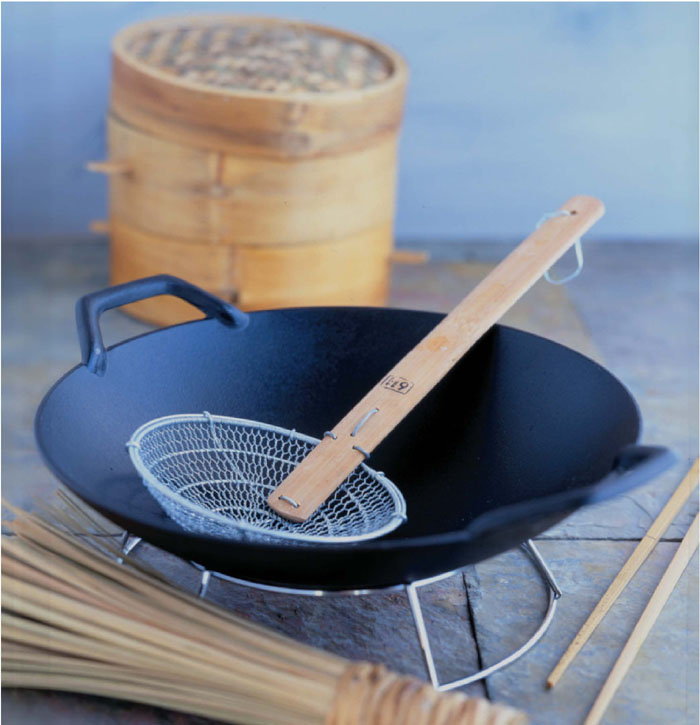
ROUND OR FLAT?
If you want to stick with tradition, get the big bowl-shaped pan with two handles made of either plain metal or metal and wood. Its the only pan to use if you have a traditional Chinese stove: a wood- or coal-fired fireplace topped by a long shelf with holes cut into it.
The woks round bottom sits in the hole over the fire and gets blazingly hotideal for cooking foods in a small amount of oil or for creating a good deal of steam. Some professional-style home stoves sold in Western countries also have optional burners designed especially for woks. Its a nice addition if you use your wok frequently and can afford both the stove and the special burner.
However, the bowl-shaped wok does not transfer well to the flat gas or electric burners of Western-style stoves. Thats why these woks come with a metal ring that sits atop the burner and holds the pan steady as you cook. This ring works fine on gas stoves, although electric stoves are a bit trickier. While the metal ring can be used successfully on electric burners, we prefer a flat-bottomed wok.
The traditional bowl-shaped wok is very deep, which allows you to control the cooking by pushing foods up the side to slow down their cooking and keeping them in the bottom of the pan for more intense heat. For example, if youve stir-fried a mixture of vegetables and chicken and want to thicken and reduce the sauce, just push the cooked ingredients up the sides of the wok, leaving the sauce in the bottom to bubble away. The depth of the traditional wok also makes it ideal for deep-frying, steaming, and boiling. The rounded bottom makes it especially easy to toss and stir foods as they cook.
The biggest disadvantage of the round-bottomed wok is that, even with the ring to hold it, the wok tends to rock and slide with vigorous stirring and tossing.
So why do we call it a wok? Wok is a Cantonese word that means cauldron or pan. The term came into wide use in the United States because many of the early Chinese settlers in North America came from southern China. In Mandarin Chinese, the word for pan is guo.
Many of the woks sold for Western kitchens have the traditional deep, sloping sides, but their bottoms are flat, making them much more stable on gas and electric burners. Although some purists say its not as easy to stir-fry foods in them as in round-bottomed woks, we think the difference is negligible. They are just as versatile as the traditional bowl-shaped woks and are ideal for most kitchens. Flat-bottomed woks often have one handle rather than two.
Some manufacturers make pans that are very similar to a wok but have somewhat shallower sides and a wider, flatter bottom. Theyre like a skillet crossed with a wok, and usually have one long handle, like a regular saucepan. These pans go by different names, including stir-fry pan, chefs pan, and

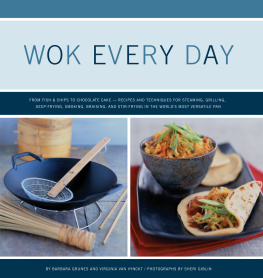


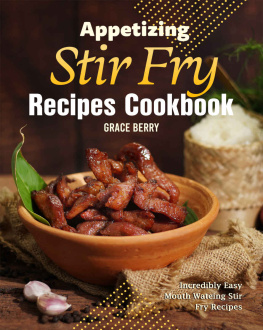
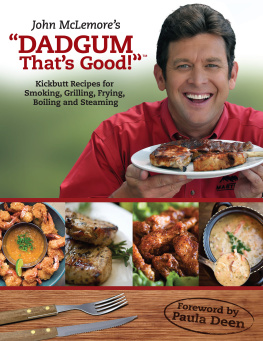
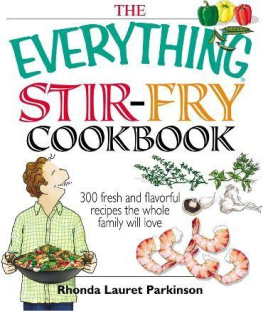
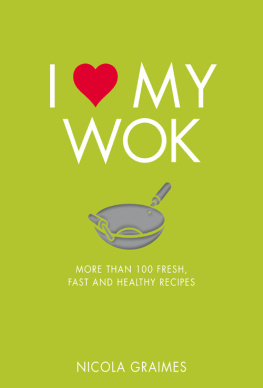

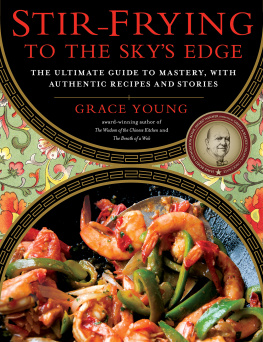


 AND WE DO MEAN ANYTHING, ANYWHERE. YEARS AGO, VIRGINIA WAS ON A HIKING TRIP IN THE HEART OF INDIAS THAR DESERTTHE VERY DEFINITION OF THE MIDDLE OF NOWHEREAND ENJOYED A SILKY, PERFECTLY COOKED CUSTARD, COMPLETE WITH CARAMELIZED SUGAR, FOR DESSERT. THE FRENCH-TRAINED EXPEDITION COOK HAD BURIED HIS WOK-LIKE PAN IN SAND HEATED BY THE WOOD FIRE TO SLOWLY BAKE HIS CRME CARAMEL. NOW THATS COOKING.
AND WE DO MEAN ANYTHING, ANYWHERE. YEARS AGO, VIRGINIA WAS ON A HIKING TRIP IN THE HEART OF INDIAS THAR DESERTTHE VERY DEFINITION OF THE MIDDLE OF NOWHEREAND ENJOYED A SILKY, PERFECTLY COOKED CUSTARD, COMPLETE WITH CARAMELIZED SUGAR, FOR DESSERT. THE FRENCH-TRAINED EXPEDITION COOK HAD BURIED HIS WOK-LIKE PAN IN SAND HEATED BY THE WOOD FIRE TO SLOWLY BAKE HIS CRME CARAMEL. NOW THATS COOKING.